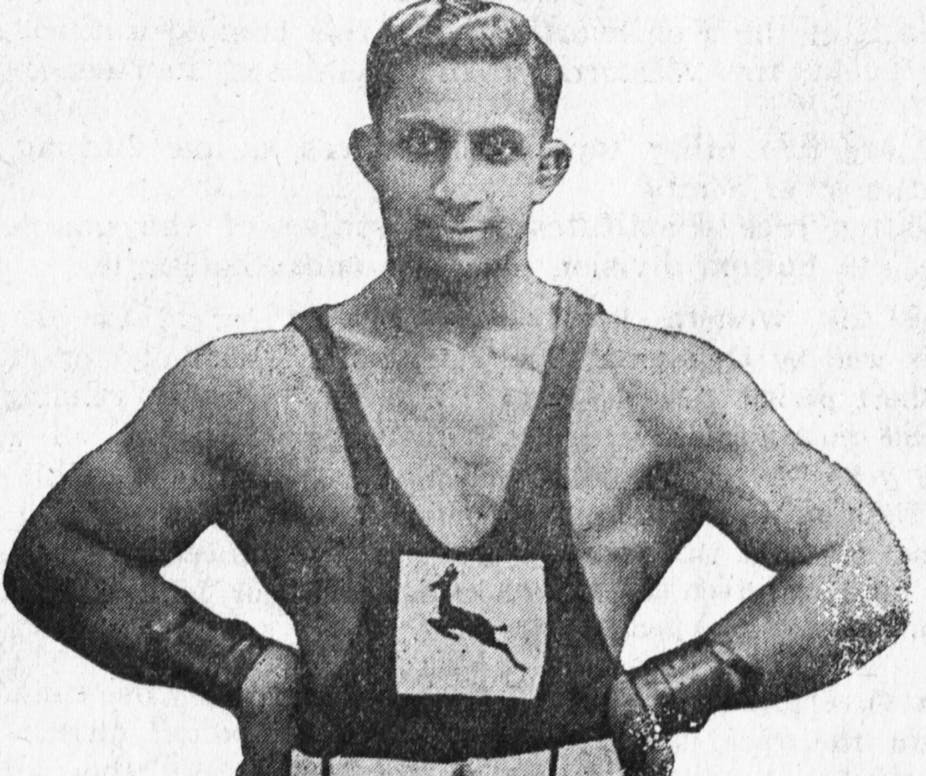A vast international body of literature exists on sports under apartheid. Yet there’s hardly any scholarship on South African black weightlifting history from earlier periods, which were also marked by racial, class and gender discrimination.
As part of the effort to fill this gap, I’ve explored the sport of organised weightlifting, and how it emerged in South Africa from physical culture. This term refers to activities to strengthen the body, enhance the physique and health, increase endurance, combat ageing and become a better athlete.
An important figure in this history is the South African-born physical culturalist Coomerasamy Gauesa (Milo) Pillay. He made a special contribution to the development of South African sport from 1920 to 1982 and to society more broadly as a community worker. He promoted physical culture and weightlifting and was a champion weightlifter himself. This was a time when racial discrimination and segregation in South Africa was the order of the day, affecting sports participation at local, national and international levels.
An exploration of Pillay’s life dispels the notion of strongmen (as early weightlifters and body builders were called) as lacking political agency. Pillay was one of the earliest black sports administrators to engage the official South African Olympic authorities and exhibited a subtle, yet highly effective, brand of agitation.
Through his and others’ efforts, black South African weightlifters later gained visibility in the outside world. These include Dennis Brutus, Chris de Broglio, Reg Hlongwane and CK (Chief) Rangasamy.
Who was Milo Pillay?
Pillay was born in Queenstown, South Africa, in 1911 or 1910 (sources differ) and died in Melbourne, Australia in 1994.
In his public political life, Pillay pursued the traditional black liberal form of protest by projecting an image of being apolitical and by writing letters to government and white sport officials. In 1945, for example, he attended a national weightlifting conference for whites in what was then the Transvaal province and attempted to get the colour bar lifted. Here he appealed to the goodwill of the officials to allow weightlifters to compete across the colour line. This was similar to his actions in community affairs, where he tried to change aspects of community life for black people by remaining on cordial terms with sympathetic ruling class elites.
Pillay’s life is significant for South African sport history, in four particular ways. First, Dennis Brutus, the anti-apartheid sports activist, said it was possible that the non-racial sports movement in South Africa started with Pillay in 1936.
Second, Pillay facilitated the shift from physical culture to weightlifting by appearing on stage performing scientific lifts as well as feats of strength. Whereas Hendrik Cornelius Tromp van Diggelen portrayed himself in the Eugen Sandow image of gladiator sandals and leopard skins, Pillay presented himself in the George Hackenschmidt mould of the champion all-round athlete. But he retained elements of the traditional physical culturalist by being a vegetarian, tee-totaller, non-smoker and believer in sun bathing, fresh air and cold swims.
Third, Pillay’s biography challenges the white monopoly on weightlifting history in South Africa. In that view, Oliver Clarence Oehley is usually described as “the father of South African weightlifting”.
Fourth, Pillay’s political actions shed a spotlight on the nuanced nature of black resistance to institutionalised racism.
Weightlifting pioneer
Pillay said he started training in 1920, with train rails and two 50-pound block weights used for scales, after he had witnessed Herman Goerner’s feats of strength in the circus and watched Elmo Lincoln in the film Tarzan of the Apes.
He gained the title of the Strongest Youth in South Africa in 1928, retaining it until 1932. The following year he established the nonracial Apollo School of Weight-Lifting in Port Elizabeth (present day Gqeberha). By 1933 it had become known as the Herculean Weight-lifting and Physical Culture Club. It was the first weightlifting club in Port Elizabeth and was affiliated to the international Health and Strength League.
Read more: Narratives about South Africa's black athletes need to be reclaimed and retold
Indicating Pillay’s growing stature, the following year the club was renamed the Milo Academy. From it emerged the Eastern Province Weight-Lifting Union and the South African Weight-Lifting Federation in the 1930s. Confirming the academy’s far-reaching effects, the Cape Town weekly newspaper the Sun said that by 1951 it had trained “over 7,000 men and women of all nationalities”, among them 400 men of the South African Air Force.
In 1933 and 1934, Pillay won the national weightlifting championships, and he was runner-up in 1935. Although he retired from active weightlifting in 1935 with a torn leg muscle, he was appointed technical adviser to the Eastern Province Weightlifting Union. According to reports in the magazine Superman in 1938 and the Sun in 1951, he was selected to represent South Africa at an international weightlifting contest in Lourenço Marques (present-day Maputo) as an official Springbok (national) athlete in 1937.

Pillay emigrated to Australia in 1982 at the age of 70, leaving behind, in Port Elizabeth, a physical culture club called the Toynbee Club. Most important, he also left a legacy of assisting to formalise weightlifting in Port Elizabeth, out of which the international sport personalities Ron Eland and Dennis Brutus developed. The South African Commonwealth weightlifting champion Mona Pretorius also comes from Port Elizabeth. These athletes and administrators would most likely not have succeeded had it not been for the contributions of Milo Pillay.
This article is one of a series on the state of African sport. The articles are each based on a chapter in the new book Sports in Africa: Past and Present published by Ohio University Press.

